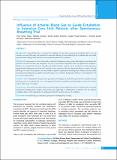Please use this identifier to cite or link to this item:
https://hdl.handle.net/20.500.14356/1190Full metadata record
| DC Field | Value | Language |
|---|---|---|
| dc.contributor.author | Keyal, Niraj Kumar | - |
| dc.contributor.author | Amatya, Roshana | - |
| dc.contributor.author | Shrestha, Gentle Sunder | - |
| dc.contributor.author | Acharya, Subash Prasad | - |
| dc.contributor.author | Shrestha, Pramesh Sunder | - |
| dc.contributor.author | Marhatta, Modh Nath | - |
| dc.date.accessioned | 2023-05-02T08:14:46Z | - |
| dc.date.available | 2023-05-02T08:14:46Z | - |
| dc.date.issued | 2020 | - |
| dc.identifier.citation | KeyalN. K., AmatyaR., ShresthaG. S., AcharyaS. P., ShresthaP. S., & MarhattaM. N. (2020). Influence of Arterial Blood Gas to Guide Extubation in Intensive Care Unit Patients after Spontaneous Breathing Trial. Journal of Nepal Health Research Council, 18(1), 21-26. https://doi.org/10.33314/jnhrc.v18i1.2114 | en_US |
| dc.identifier.issn | JNHRC Print ISSN: 1727-5482; Online ISSN: 1999-6217 | - |
| dc.identifier.uri | http://103.69.126.140:8080/handle/20.500.14356/1190 | - |
| dc.description | Original Article | en_US |
| dc.description.abstract | Abstract Background: Arterial blood gas is required for extubation decision after spontaneous breathing trial in most of intensive care unit. This study was conducted to assess the influence of arterial blood gas for extubation after successful spontaneous breathing trial in intensive care unit patients planned for extubation. Methods: It was prospective observation study conducted in all patients of age greater than eighteen year admitted in intensive care unit of tertiary care hospital for one year. It was done in 108 patients who were planned for extubation. Patients were assessed by intensivist clinically and decided whether a patient can be extubated on clinical grounds. Spontaneous breathing trial was done for 2 hours by t-piece in patients who met clinical and objective criteria. Arterial blood gas was done in all patients who successfully completed spontaneous breathing trial. Patients with successful spontaneous breathing trial, acceptable arterial blood gas were extubated. Independent Student’s t test and paired t test was used for data analysis. Results: Out of 108 patients who passed the spontaneous breathing trial, 96(88.88%) patients had acceptable arterial blood gas and were extubated and 12(11.11%) patients did not have acceptable arterial blood gas level and were chosen to have other mode of weaning. Conclusions: This study demonstrates that arterial blood gas level has changed decision for extubation after successful spontaneous breathing trial. Further, arterial blood gas might help in identification of patients who can undergo extubation failure when rapid shallow breathing index failed to predict outcome of extubation. Keywords: Arterial blood gas; extubation; spontaneous breathing trial; weaning | en_US |
| dc.language.iso | en | en_US |
| dc.publisher | Nepal Health Research Council | en_US |
| dc.relation.ispartofseries | Jan-Mar 2020;2114 | - |
| dc.subject | Arterial blood gas | en_US |
| dc.subject | Extubation | en_US |
| dc.subject | Spontaneous breathing trial | en_US |
| dc.subject | weaning | en_US |
| dc.title | Influence of Arterial Blood Gas to Guide Extubation in Intensive Care Unit Patients after Spontaneous Breathing Trial | en_US |
| dc.type | Journal Article | en_US |
| local.journal.category | Original Article | - |
| Appears in Collections: | Vol. 18 No. 1 (2020): Vol. 18 No. 1 Issue 46 Jan-Mar 2020 | |
Files in This Item:
| File | Description | Size | Format | |
|---|---|---|---|---|
| 2114-Manuscript-14300-1-10-20200420.pdf | Fulltext Article. | 218.4 kB | Adobe PDF |  View/Open |
Items in DSpace are protected by copyright, with all rights reserved, unless otherwise indicated.
